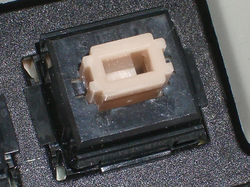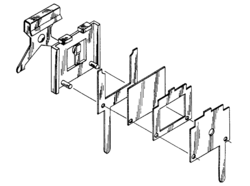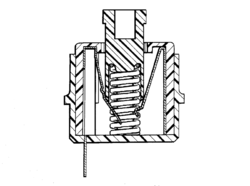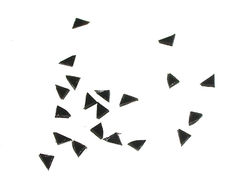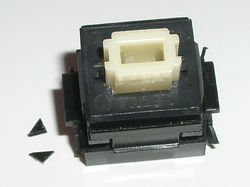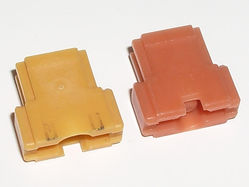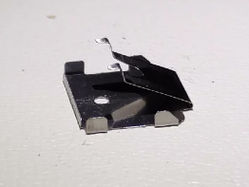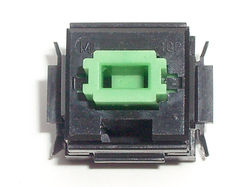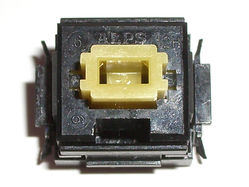Alps SKCL/SKCM series
| This article requires illustration in the form of diagrams — need disassembly diagrams, and diagrams showing operation |
| This article requires additional photographic illustration — pictures of Alps SKCL/SKCM Cream, SKCM Green & SKCL Double Action are missing |
Alps SKCL/SKCM series switches, commonly referred to as complicated Alps, Alps Bigfoot, and Alps CM, are the most common type of Alps switches used in computer keyboards. First introduced as early as 1983,[1] the Alps SKCL/SKCM series has been one of the first commonly available, compact-design keyboard switches. Over the years there have been many variants of the keyswitch, including changes in colour and design. Early variants of the Alps switch did not carry the Alps logo on the top part of the case, and only had it stamped in on the switch bottom.
The terms "ALPS" and "Alps" are widely misused to refer to a large number of clone switches manufactured by other companies, as well as similar-looking switches that share the same keycap mount; although most clones are clearly different from genuine Alps switches, they are similar enough that many people fail to differentiate Alps switches from the copies.
Contents
Nomenclature
Alps SKCL/SKCM series has gone by many names, owing to widespread misunderstanding. "Alps CM" was coined from a misunderstanding of Alps part numbers and is not considered correct, and it does not cover the linear switches (SKCL). "Bigfoot" as a moniker derives from the term "Alps Bigfoot" used to refer to the Alps standard keyboard platform, best recognised in the West in the form of the Alps-made Dell AT101. "Complicated Alps" is not an official term, but it does serve as a convenient term to describe the SKCL/SKCM series, with a fairly high 10–13 parts per switch, especially in comparison to the "simplified" Alps SKBL/SKBM series that followed it.
The Alps data sheet below uses the term "SKCL/SKCM series" ("SKCL/SKCMシリーズ"). The switches all have a basic six-letter part number, of which the first four letters are either "SKCL" (linear) or "SKCM" (tactile, including clicky). Two further letters identify the model of switch, and additional numbers and letters appear to follow the part number proper, and their meaning is not understood. Some part numbers have been obtained and are listed in the table below; most part numbers remain unknown.
There is no known name or term that covers both complicated (SKCL/SKCM) and simplified (SKBL/SKBM series) switches. According to Sandy, 'SK' stands for "single key"; "SK" is used in the part numbers of many Alps switches.[2]
A useful mnemonic for dealing with Alps part numbers, is "L" for "linear" (SKCL and SKBL), and to imagine that the "C" in SKCL/SKCM stands for "complicated" (and possibly "B" for "basic" in SKBL/SKBM).
Evolution
The SKCL/SKCM design was modified numerous times by Alps over its lifetime. This process remains poorly understood, but a number of changes have been noted. Some of these points are expanded further under Design, below.
- The original SKCL shell from ca. 1983 used longer, potentially more fragile tabs between the slits, and black switchplates
- When SKCM was introduced shortly afterwards, the new non-LED shell used shorter slits
- Around 1984 or so, the switchplate colour changed from black to grey
- Around 1989, all the slider colours changed, with the suggestion being that a newer, smoother plastic was used (this can be seen in the shinier sliders of switches from this point onwards and the lack of dry lubricant on switches from this period onwards); this was not a clean break, as SKCM White continued to use dry lubricant briefly after it replaced SKCM Blue,[3] and uncertainty remains as to which older switches correspond to which newer switches
- The 1989–1990 overhaul also saw the introduction of top branding on switches—using the newer Alps logo—and SKCL switches changed over to the shorter tabs between the slits when the shells were retooled (noticeable in comparison between typical SKCL Green and typical SKCL Yellow)
- Other changes during the 1989–1990 overhaul included switchplate alterations, first to colourless plastic, and then to a shorter version; as with the other changes, these occurred in a series of transitions
- Some switches around the end of the 80s had dark grey-blue upper shells instead of black; the timeframe for this remains uncertain, but SKCM Orange, White and Cream Damped are known to be amongst those affected
- Around 1993, the slits were removed entirely
Design
Alps SKCL/SKCM series is widely referred to as "complicated Alps", due to the design of the switch. SKCL switches have a fairly high count of 10 parts per switch, and the click or tactile leaf of an SKCM switch brings this to 11. The complexity comes from the switchplate, the assembly that contains the electrical contacts.
The switchplate that gives "complicated" Alps switches their complexity
Disassembled Alps SKCM White switch; SKCL/SKCM switches have a high number of constituent parts
Shell
The original design was a linear switch, with a hole in the upper shell to take an integrated LED. The tactile or click leaf needs to occupy this slot, making tactility and illumination mutually exclusive; this design limitation would become a problem with the Matias Tactile Pro series, where customers mistook the necessarily linear LED key switches as manufacturing defects.
All standard linear switches have a recess for an LED. Surprisingly, most of these switches will not actually accept an LED, as there are no holes in the base for the LED legs. Separate part numbers existed for the LED versions, one per LED colour. The front securing tab for the shell also contains a clearance recess to provide room for the LED, which is also absent in the non-LED versions of linear switches. This clearance recess is subtle, but it is nonetheless visible in photographs of both yellow and green Alps switches.
In the 1980s, the whole switch shell was made of black plastic. At the very end the 80s, or the early 90s, the upper shell mouldings changed from black to dark grey. From this point onwards, switches would have two-tone grey-black shells, although they appear to have reverted to all-black again a while later.
Not long after this point, the Alps logo was added to the upper shell, allowing switches made from that point onwards to be positively identified as Alps Electric products instead of Alps clones. The exact weight of typeface of the Alps logo varied between mould, and later it would change to boldface text.
The lower shell has four "wings" that retain the switch against the mounting plate. These wings may snap off or become weakened, possibly when removing switches from keyboards.
Alps SKCM Orange switch with two-tone shell
Alps SKCM Cream Damped switch with missing wings
Slider
The slider (Chinese and Japanese, "軸") is the moving connector between the keycap and return spring. The slider colour helps to identify the switch variant, in combination with other details such as the upper shell design.
Alps sliders are horizontally symmetrical (the right side mirrors the left side), but in most cases they are not rotationally symmetrical: the back is not a mirror of the front, and the slider is not considered to be reversible. In particular, there is a small notch cut into the base at the rear; this side always faces the switchplate. The notched side also has a rounded edge, presumably to ensure smooth actuation and minimize contact bounce. The front side of the slider has a sharp edge which minimizes drag against the tactile leaf. Because of this, reversing the slider will make the switch feel heavier and less crisp. This design was maintained with Alps SKBL/SKBM series "simplified" Alps, but no Alps clone switches are known to have copied this characteristic, as they all have reversible sliders.
Alps SKCL Green is an exception here in that the slider is reversible, has a longer spring support stem, and equally-sized small notches on both sides. The change was not retained for Alps SKCL Yellow.
Leaf springs
Alps SKCL/SKCM series was quite likely to be the first switch series to use a folded leaf spring to provide a tactile sensation and audible indication. Following on from Alps SKCC series, the original SKCL switches were linear. It appears that the first attempt at tactile feedback was the Alps SKCM Brown; this was a skeleton switchplate designed to expand the tactility inherent in the actuator leaf design.
This was shortly followed by Alps SKCM Blue, which introduced the idea of a folded leaf spring that is pulled away from the inside of the shell by the slider, and allowed to snap back into place to generate an audible sound. Blue Alps switches appeared around 1985, while the earliest SMK second generation switches have been found from 1986.
The click leaf concept was subsequently used in many switches, including SMK second generation switches and the Omron B3G-S series as well as most Alps clone switches, Alps derivatives, and Alps-SMK hybrid switches such as the KPT switch.
The progression of the tactile leaf is not clear; it may have been a derivative of the click leaf, or it may be that both designs were introduced at the same time, as Alps SKCM Cream, which so far has been found to have a standard folded tactile leaf. The folded tactile leaf is similar to the click leaf, but two additional protrusions prevent it from being pulled forward, so it does not generate a click. The consequence of this design is that the tactility is not as strong as that generated by a click leaf. Tactile leaves often have a hole stamped in the centre; the reason for this is not known. It appears to have been absent in SKCM Cream, then present for Alps SKCM Orange onwards, and removed again with Alps SKCM White Damped.
Click leaf in an Alps SKCM Amber switch
Modification
It is possible to modify a tactile leaf spring to produce a click. This is done by bending down the two upper tabs, which allows the leaf to move within the slot in the upper housing. This affects both the feel and the sound of the switch.
Switchplate
The switchplate is a six-part sandwich assembly containing the electrical switch contacts. It contains two terminals, with a flexible metal foil membrane placed against the first that is held apart from the second by a plastic separator. This assembly is held inside a plastic plate, above which a sprung actuator leaf is fitted. The slider bends the actuator leaf back against the plastic plate, where it presses a flap against the foil membrane, which is pressed against the rear terminal.
The plastic block initially extended down to the base of the shell; this is a known as a "long" switchplate. Later switches had this plastic block reduced in height, leaving a gap between it and the bottom of the shell; this is termed a "short" switchplate. There has been speculation that reducing the length of the switchplate degrades the smoothness of the switch, but this seems unlikely. Short switchplates are supported by two small posts adjacent to the holes for the legs.
The colour of the switchplate has also changed twice. Early switches used the black switchplates from Alps SKCC series switches. The colour was soon changed to grey, with no other apparent change. Around 1987, the colour was changed again, to translucent white, which would be the final colour. The height was changed from long to short soon afterwards, around 1988.
In most switches, the switchplate is at the rear of the switch with respect to the orientation of the numbering and branding. Alps SKCM White was an exception, with certain production runs having the branding orientated "upside down", seemingly randomly between the different moulds in the tooling. Alps clone switches frequently placed the contacts at the front of the switch instead, and simplified Alps switches appear to have reversed the orientation initially.
Latching action
As with so many other vintage switch families, the SKCL series includes a latching action switch. This replaced the LED or leaf area with a follower arm. This switch was produced in two separate slider colours (cream and grey) with no known distinction between them. Alps SKCL Lock was widely used in Apple keyboards for the caps lock key, as Apple used latching caps lock keys in all their keyboards for years; other Alps switch keyboard manufacturers were more likely to use integrated LED switches instead.
Slits
On switches made up to 1993, the slider aperture contained a pair of prongs, one per side, possibly designed to dampen the impact of the return stroke. The resulting appearance of a switch shell with these prongs is described as "having slits", one above and one below each prong. These prongs, and thereby the slits, disappeared around 1993. MouseFan in particular considers the switch quality to have degraded around the time that the slits disappeared.[1]
Based on MouseFan's terminology, switches with slits can be referred to as "pine" (「松」, matsu) and switches without slits as "bamboo" (「竹」, take) based on the Japanese three-tier grading system, with pine as the highest grade.[4]
The length of the tabs enclosed by the slits also changed with time; the tabs, and thereby the slits, had reduced in length after a couple of years. The longer tabs were potentially more prone to damage when pulling keycaps, as the tabs bear the strong keycap removal force by holding the slider down.
Logo
Early Alps SKCL/SKCM switches only bore the Alps logo on the bottom, where it could not be seen without removing the switch from the keyboard. Around 1988, Alps added their new-style logo the top of each switch, just after Alps SKCM White was introduced. At least two variants of this logo can be found, as Alps broadened the strokes of the letters.
The lack of visible branding on older Alps switches is one of the aspects of confusion between genuine Alps parts and clone switches, as most clone switches are completely unbranded.
Simplified Alps
Simplified Alps switches seem to have first appeared around 1996.[1] Simplified Alps was a redesign of the switch to remove the complexity of the switchplate system. Instead of a switchplate, the actuator leaf is part of the front terminal, as with Alps clone switches.
Simplified Alps switches share the same exterior design, but the logo and mould numbering differ, making recognition fairly straightforward
Pine Alps SKCL/SKCM with slits, complex mould numbering and low relief lettering; later complicated Alps switches lost the slits
Recognition
When examining unbranded Alps-style switches on a keyboard, the key detail to look for is the number of side tabs that support the switch in the mounting plate. If the switch has four small tabs (a so-called "four-tab clone"), it is certainly a clone. If the switch has two long side tabs, it is relatively likely to be genuine Alps (especially if the board dates back to the 1980s), but there are copies of the switch with long tabs.
Four small tabs:
guaranteed to be a clone or derivative
Variants
Official information on Alps keyboard switches is extremely scarce. The years in the table below are mostly the result of observations by MouseFan,[1] and only indicate the earliest and latest known instances of the switches in question. Many of the part numbers were obtained by Sandy from a paper copy of the 1994 Alps catalogue that circulated in the Japanese keyboard community, of which the original version and the scanned PDF are now lost. Specific information relating to each switch can be found on its respective page.
In some instances, heavier weight switches have been marked with black paint across the top of the slider, instead of a separate plastic colour.[5][6]
| Switch | Type | Key feel | Force | Years found | Logo | Part numbers | Notes | |
|---|---|---|---|---|---|---|---|---|

|
Alps SKCL Green | Normal | Linear | 50 gf | 1983–1989 | |||

|
Alps SKCL Yellow | Normal | Linear | 0.588N (1994) | 1988–1998 | Later switches | SKCLAR SKCLFQ SKCLFM |
Present in 1994 catalogue |

|
Alps SKCL Cream | Normal | Linear | |||||

|
Alps SKCM Amber "Taxi yellow" |
Normal | Clicky | 1986–1988[7] | ||||
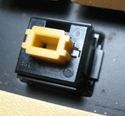
|
Alps SKCL Amber | Spacebar | Stiff linear | |||||
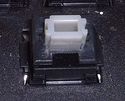
|
Alps SKCL Grey | Space bar | Stiff linear | 0.882N (1994) | Some | SKCLAQ | Present in 1994 catalogue | |

|
Alps SKCL Heavy Grey | Special | Stiff linear | |||||

|
Alps SKCL Brown | Normal | Linear | |||||

|
Alps SKCM Brown | Normal | Tactile | |||||

|
Alps SKCM Blue | Normal | Clicky | 70 gf | 1985–1988 | No | SKCMAG | |

|
Alps SKCM Cream | Normal | Tactile | 70 gf | SKCMAF | |||

|
Alps SKCM Orange | Normal | Tactile | 1987–1991 | Later switches | |||

|
Alps SKCL Lock | Latching action | Tactile | 1.47N | Grey: yes | SKCMJC | Present in 1994 catalogue; found with both cream and grey sliders | |

|
Alps SKCM White | Normal | Clicky | 0.686N | 1988–1996 | Normally | SKCMAQ SKCMCQ? |
SKCMAQ is from the 1994 catalogue; SKCMCQ is from the specification listed below, which appears to be the same |

|
Alps SKCM Salmon | Normal | Tactile | 1988–1992 | Yes | |||
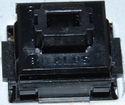
|
Alps SKCM Black | Normal | Tactile | 0.686N | 1988–1996 | Yes | SKCMAP | Present in 1994 catalogue |

|
Alps SKCM Cream Damped | Normal | Damped tactile | 0.686N | 1988–1994 | SKCMBB | Referred to as "ivory" in the 1994 catalogue; the exact shade appears to vary and can even be white | |

|
Alps SKCM Green | Normal | Tactile | 0.686N | SKCMAT | Present in 1994 catalogue | ||

|
Alps SKCL Double Action | Double Action | SKCLKB | Present in 1994 catalogue | ||||
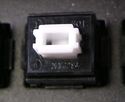
|
Alps SKCM White Damped | Normal | Damped tactile | ca. 1995 | Yes |
Keyboards
Specifications
- 5454_31 (SKCLAR and SKCMCQ)
External links
- Ripster Guide: Taking apart ALPS switches Dated 2012. Retrieved 2015-07-21.
References
- ↑ 1.0 1.1 1.2 1.3 MouseFan — ALPS Retrieved 2015-07-21.
- ↑ Alps.com — Snap-in Type TACT Switch Retrieved 2015-07-21.
- ↑ Deskthority — Alps Appreciation
- ↑ Digi-joho Japan B2B Portal — Matsu Ta-ke Ume - A traditional ranking system in Japan Retrieved 2015-07-21.
- ↑ MouseFan — PC-8801mkⅡSR '85 Retrieved 2015-07-21.
- ↑ Deskthority — ADDS 1010 Green Alps Teardown
- ↑ Deskthority — Convert Apple IIc to usb (post 12)


